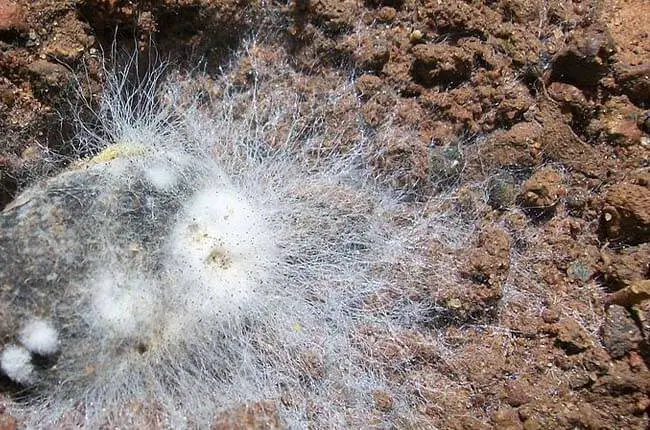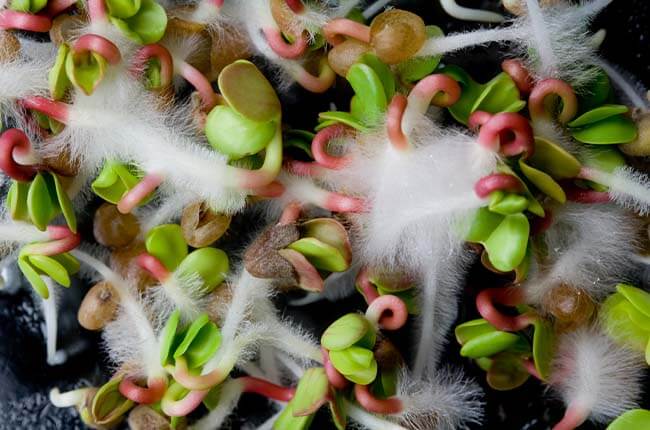When white fuzz appears on seedlings or seeds, many people mistake it for mold and throw their plants away. Chances are it is healthy root hair that often develops on the young roots of seedlings and even on aerial roots.
Being able to tell the difference between root hair and mold is important especially if you are growing microgreens for your salad. So, how can we identify one from the other?
Root hair has a bright white color and radiates from the roots only. It helps the plant to absorb moisture and nutrients. Mold or mildew, in contrast, has a white grayish tint, appears not only in the root zone and spreads everywhere with long threads like a spider web.
In this article, we look at how to identify root hair and mold, the functions of root hair, what to do when you find mold and how to prevent it.
Let’s begin.
1. Is the white fuzz root hair?
1.1 What does root hair look like?
Root hair congregates only around the root zone. It grows mostly on young roots, which can be the roots of seeds, seedlings, or microgreens. They can also be on the young aerial roots of plants such as Monstera, Pothos, Philodendron, Ficus.
Root hair is white, feels very soft to touch, and can grow up to 1 mm in length.
The white fuzzy root hair disappears for hours after coming into contact with water.
You can do a spray test by sprinkling water on your white fuzz. If it is root hair, the white fuzz will disappear as it absorbs water.
In addition, fuzzy root hair will continue growing and increasing in size.

1.2 Structure of root hair
Root hair is tubular-like extensions that grow from the epidermal cells of plant roots.
They tend to grow laterally and will rarely branch out; in addition, they grow on the matured part of the root away from the root tip.
1.3 What causes roots to grow fuzzy hair?
Because of a higher interface area with the soil or air, the primary function of roots hair is the absorption of nutrients and moisture from the soil (or from the air for aerial roots)and transfer them to the plant.
Root hair also increases the interaction with microbes such as nitrogen-fixing bacteria, which helps convert minerals in the soil into readily available forms for plant uptake.
The root hair also helps find the way in the soil for the roots to elongate in the space between the soil particles.
The coat of root hair also helps to stabilize the plant by gripping onto the soil particles (or for aerial roots to grip onto a surface as support and climb up).
1.4 What should you do with fuzzy root hair?
Root hair does not pose any threat to your plant, so you do not need to do anything.
Do you try to remove the plant’s root hair as that would be cutting open a wound and thus make it more vulnerable to infection.
2. Is the white fuzz mold?
2.1 How to identify mold?
Mold or mildew is a fungus that grows in cotton-like threads known as hyphae. Unlike root hair, the mold hyphae do not have a bright white color. Rather it has a grayish tint to it.
Also, mold tends to grow in long, disorganized web-like structures and can be found wherever that is damp, including the soil (and not only in roots). In essence, you can’t tell where it emanates from.
It also feels like loosely dried cotton.

2.2 What causes mold to grow?
Mold or mildew is common in warm, humid environments with poor ventilation.
This happens to plants that are grown too close to each other, especially in soil that is overwatered or with poor drainage, with water remaining on the leaves and under inadequate air circulation.
This is also common in indoor gardening. That is why it is common to see mold in microgreens or when sprouting seeds because they are often grown or germinated in a damp enclosure with little space in between.
2.3 What to do with mold on plants?
Once you notice mold on your plant’s roots, you should also isolate the plant immediately since mold can quickly spread to other plants.
You need to remove the mold present by simply rubbing it off. Or, you can apply an organic fungicide to remove the mold.
You can make the organic fungicide by mixing 1 tbsp of baking soda in 1 gallon of water.
2.4 How to prevent mold on plants?
To prevent mold from appearing, you can take the following precautions:
- Use a fan or move the plants to a spot with good air circulation.
- Avoid leaving water on the plant. Instead of watering from above or misting, try bottom watering if possible.
- Water less. Avoid sticking to a strict watering schedule. Instead, check that the soil is dry before you water the plants.
- Perform daily checks on your plants for symptoms of mold formation.
3. How do you know you have root rot?
If there is really mold on the roots and you did not remove it in time, it could develop into root rot.
The early signs of root rot include the development of some yellow or even brown mushy parts that can easily slip away.
For a more serious case of root rot, the plant may also start to wilt and you will also notice a strong and unpleasant smell.
Root rot can be cured by repotting it in a fresh, clean medium and changing the watering habit. Here is an article to learn more about the ways to cure root rot in orchids.
4. What plants often have fuzzy root hair?
Monstera
Monstera deliciosa, also known as the swiss cheese plant, belongs to the arum family and is a hemiepiphyte with aerial roots.
Aerial roots develop to help the plant in nutrient absorption.
Pothos
Pothos regularly develop a coat of root hair on their ground roots and aerial roots to absorb water, especially if you put the plant in water or water it regularly.
Since Pothos is a climbing plant, it also uses its root hair to latch itself on a surface as support.
Philodendron
All species of Philodendron develop aerial roots that provide them with stability as they grow. Root hair also grows to absorb nutrients.
Ficus
Most Ficus trees, commonly known as bonsai trees, develop root hair in their young aerial roots for moisture uptake in the air.
Microgreens
Microgreens, or young vegetable seedlings that are grown indoors, often develop a thick coat of hair on their roots to absorb water and nutrients.
Microgreens are easily susceptible to mold because they are grown very close to each other indoor in a humid environment.
Conclusion
To sum up, root hair and mold can easily be distinguished by checking the color, its location on the plant, and the forms.
Root hair should have a bright white color, while mold has a grayish tint. Root hair only appears in the root zone, but mold can appear anywhere like spider webs.
If your plant and seedlings do indeed have mold, you will need to remove the fungi immediately to prevent it from spreading.
Happy growing!
Related
Why My Succulent Has Aerial Roots (Is It Bad?)
Saving A Rootless Orchid? (3 ICU Setups You Should Know)
References
Grierson, C., Nielsen, E., Ketelaarc, T. & Schiefelbein, J. (2014). The Arabidopsis Book, 2014(12).
Jungk, A. (2001). How roots find a route.
Lim, T.K. (2012). Monstera deliciosa. In: Edible Medicinal and Non-Medicinal Plants. Springer, Dordrecht.
Xiao, Z., Lester, G. E., Luo, Y., & Wang, Q. (2012). Assessment of vitamin and carotenoid concentrations of emerging food products: edible microgreens. Journal of Agricultural and Food Chemistry
Zotz, G., Winkler, U. (2013). Aerial roots of epiphytic orchids: the velamen radicum and its role in water and nutrient uptake. Oecologia 171, 733–741
Shivanna, M. B., Meera, M. S., & Hyakumachi, M. (1996). Role of root colonization ability of plant growth promoting fungi in the suppression of take-all and common root rot of wheat. Crop Protection, 15(6), 497-504.
Photo credits:
Oregon Caves from Cave Junction, USA, CC BY 2.0, via Wikimedia Commons
SHIRAS WC, CC BY-SA 4.0, via Wikimedia Commons
- Keiki Paste vs Rooting Hormone:What’s the difference? - February 4, 2024
- Top 10 Orchid Fertilizers: A Comprehensive Review (2024) - February 2, 2024
- Top 8 Soil Inoculants For Stronger Plants (2024) - February 1, 2024


